Mobile photos tell your personal story by capturing authentic moments and genuine emotions. You'll create powerful narratives through candid shots, unique perspectives, and clever composition techniques. Light, shadow, and color play essential roles in evoking feelings and setting the mood. Your smartphone's features, like portrait mode and night mode, enhance storytelling possibilities. By mixing candid and posed shots, you'll build a well-rounded narrative that reflects your experiences. Environmental elements and careful sequencing add depth to your visual tale. As you develop a consistent style and share strategically on social media, you'll craft a compelling personal story that resonates with viewers. The journey of visual storytelling unfolds with each snapshot you take.
Capturing Authentic Moments

Mobile photography's greatest strength lies in its ability to capture life's fleeting moments. With your smartphone always at hand, you're ready to freeze-frame authentic slices of life as they unfold.
Unlike staged photoshoots, mobile photos often catch raw emotions, unguarded expressions, and spontaneous actions that tell your personal story more genuinely.
To capture these authentic moments, stay alert and observant. Train your eye to spot interesting compositions in everyday scenes.
Don't hesitate to snap candid shots of friends and family during casual interactions. These unposed images often reveal personalities and relationships more truthfully than formal portraits.
Embrace imperfections – a slightly blurry action shot or an off-center composition can add character to your photo story.
Use your phone's burst mode to capture a series of images during dynamic moments, ensuring you don't miss the perfect shot.
Experiment with different angles and perspectives to add visual interest and depth to your storytelling.
Emotional Resonance in Images
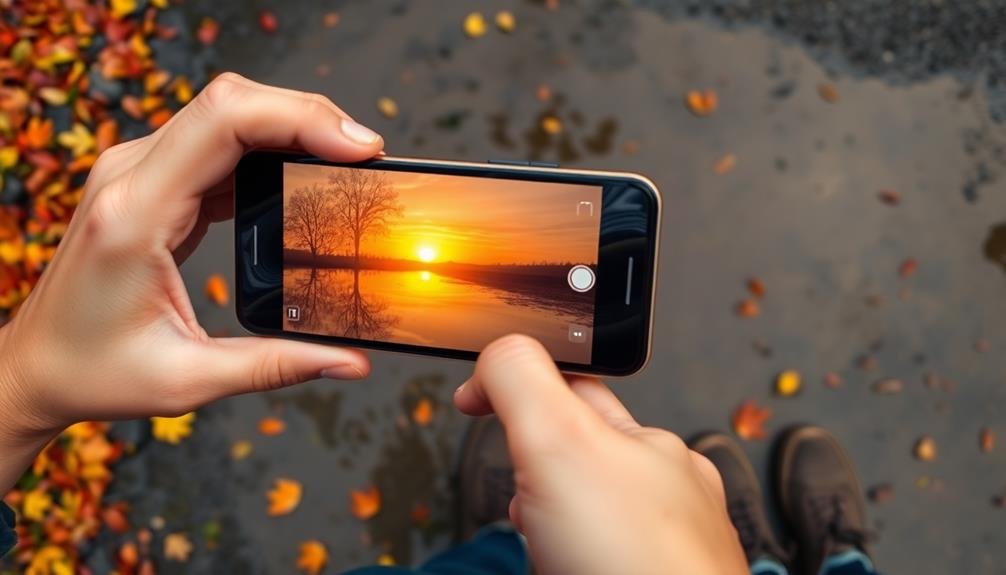
While capturing authentic moments is key, the true power of mobile photography lies in its ability to evoke emotions. Your smartphone camera can become a tool for creating images that resonate deeply with both you and your viewers. To achieve this emotional impact, focus on composition, lighting, and subject matter that speaks to universal human experiences.
Pay attention to facial expressions, body language, and environmental cues that convey mood. Use color to enhance the emotional tone of your images, whether it's the warm glow of a sunset or the cool blues of a rainy day.
Don't shy away from capturing challenging emotions like sadness or frustration; these can often result in the most powerful and relatable images.
Consider the story behind each photo and how it connects to your personal narrative. What does this moment mean to you? How does it reflect your values, relationships, or experiences?
Composition and Personal Perspective
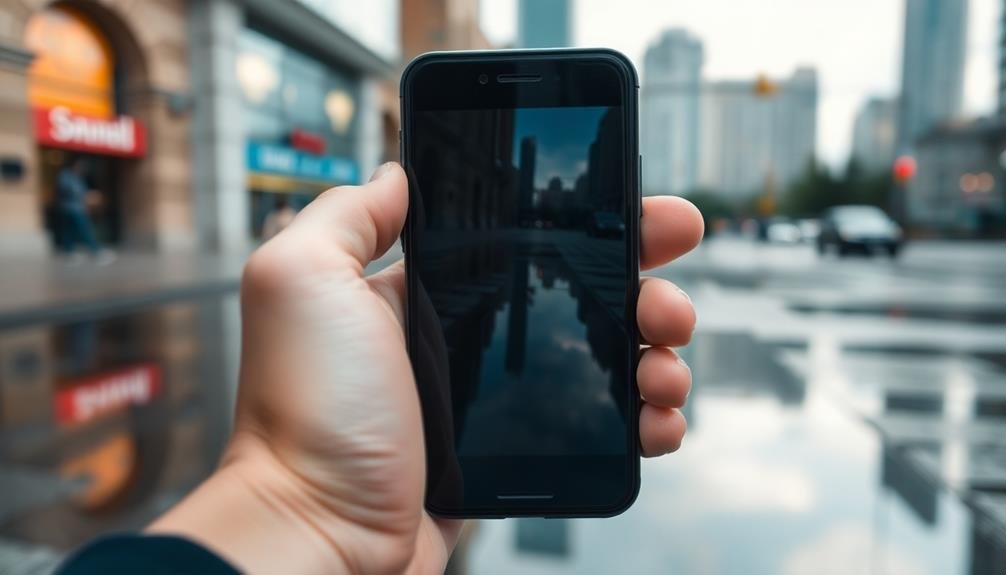
Your mobile camera allows you to frame personal moments from unique angles, creating a distinct perspective on everyday life.
By applying the rule of thirds, you'll add visual interest and balance to your images, drawing the viewer's eye to key elements.
These compositional techniques help you craft photos that tell your personal story more effectively, turning ordinary scenes into meaningful visual narratives.
Framing Personal Moments
Capturing personal moments through mobile photography is as much about perspective as it's about technique. When framing your shots, consider how you want to convey your personal story. Focus on elements that hold emotional significance or represent key aspects of your life. Use your smartphone's camera to experiment with different angles and compositions that best capture the essence of the moment.
To effectively frame personal moments, keep these tips in mind:
- Get close to your subject for intimate shots
- Use leading lines to draw attention to the focal point
- Incorporate negative space to create visual balance
- Play with symmetry or asymmetry for added interest
- Utilize the rule of thirds for dynamic compositions
Remember that your unique perspective is what makes your photos personal. Don't be afraid to break traditional rules if it helps convey your story more authentically.
Pay attention to lighting and how it affects the mood of your images. Experiment with shadows and highlights to add depth and dimension to your shots.
Capturing Unique Angles
To stand out from the crowd, you'll need to think outside the box when it comes to capturing unique angles with your mobile phone.
Experiment with different perspectives to add depth and interest to your photos. Try shooting from ground level to create a sense of grandeur or climb to a higher vantage point for a bird's-eye view.
Don't be afraid to tilt your phone or capture diagonal lines to add dynamic energy to your compositions.
Consider using leading lines to draw the viewer's eye through the frame. Look for natural patterns, shapes, or architectural elements that can guide the gaze towards your main subject.
Play with symmetry and reflections to create visually striking images. You can also use foreground elements to frame your subject and add depth to your photos.
Rule of Thirds
One of the most fundamental principles in photography, the rule of thirds can transform your mobile snapshots into compelling visual stories. This technique involves dividing your frame into a 3×3 grid and placing key elements along these lines or at their intersections.
By doing so, you'll create more balanced and visually appealing compositions that draw the viewer's eye to the most important parts of your image.
To effectively use the rule of thirds in your mobile photography:
- Turn on the grid feature in your phone's camera app
- Place your main subject at one of the intersecting points
- Align horizons with the top or bottom horizontal line
- Position vertical elements along the left or right vertical lines
- Experiment with off-center compositions for added interest
Light and Shadow Play
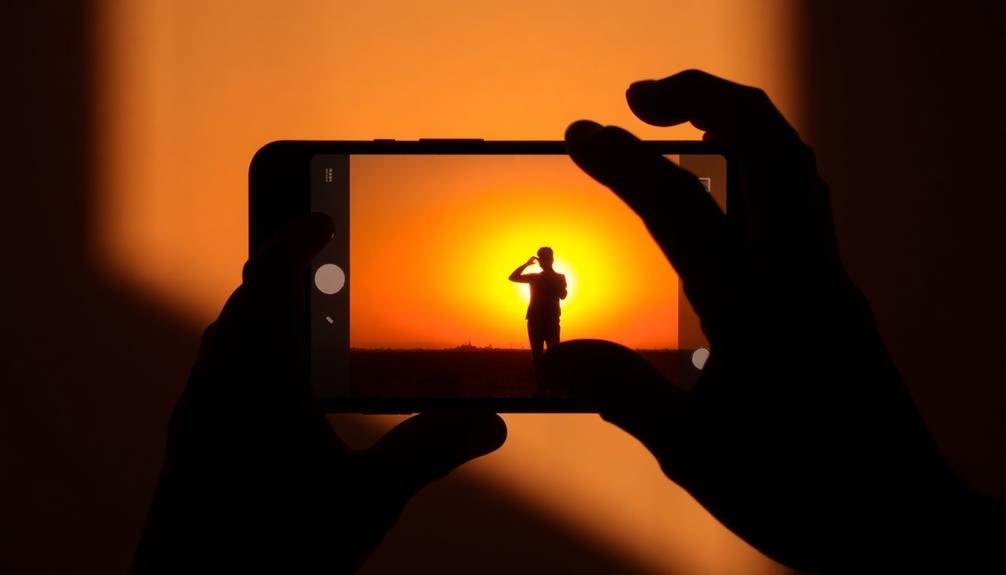
Light and shadow play can transform your mobile photos into compelling visual stories.
You'll create depth and drama by capturing stark contrasts between illuminated areas and dark recesses.
Experiment with emphasizing your subject's silhouette against a bright background to add mystery and intrigue to your personal narratives.
Capturing Dramatic Contrasts
Dramatic contrasts between light and shadow can transform an ordinary scene into a mesmerizing visual story. When you're capturing these contrasts with your mobile phone, look for scenes where light and dark areas create striking visual tension. Seek out strong light sources, like sunbeams filtering through trees or streetlights illuminating a foggy night.
To effectively capture dramatic contrasts:
- Use HDR mode to balance bright and dark areas
- Experiment with exposure compensation
- Focus on the brightest or darkest area for emphasis
- Try silhouette shots against bright backgrounds
- Play with shadows to create interesting shapes
Remember, it's not just about technicality; it's about evoking emotion. A dramatically lit portrait can convey mystery, while harsh shadows on a cityscape can create a sense of urban grit.
Don't be afraid to push the boundaries of your phone's camera capabilities. Sometimes, embracing the limitations of mobile photography can lead to unexpectedly powerful results.
As you practice capturing dramatic contrasts, you'll develop a keen eye for light and shadow interplay. This skill will elevate your personal storytelling, allowing you to create more impactful and emotionally resonant images with your mobile device.
Creating Depth Perception
While dramatic contrasts can create striking images, mastering depth perception takes your mobile photography to the next level. By manipulating light and shadow, you'll add a three-dimensional quality to your photos, making them more immersive and engaging.
To create depth, focus on layering your shots. Place objects in the foreground, midground, and background to guide the viewer's eye through the image. Use leading lines, such as paths or roads, to draw attention deeper into the scene. Experiment with perspective by getting low or shooting from above to add visual interest.
Play with light sources to cast shadows that create depth. Side lighting can accentuate textures and forms, while backlighting can create striking silhouettes. Use your phone's HDR mode to capture details in both highlights and shadows, enhancing the sense of depth.
Don't forget about bokeh, the blurry background effect. Portrait mode on newer smartphones can simulate this, separating your subject from the background.
Emphasizing Subject Silhouettes
Silhouettes offer a powerful way to create striking, emotionally charged images with your mobile phone. By emphasizing the outline of your subject against a bright background, you can create a sense of mystery, drama, or serenity in your photos. To capture compelling silhouettes, position your subject between your camera and a bright light source, such as the sun or a window.
When shooting silhouettes, focus on:
- Finding strong, recognizable shapes
- Experimenting with different angles
- Ensuring a clean, uncluttered background
- Adjusting exposure to darken the subject
- Capturing motion for dynamic silhouettes
You'll want to expose for the bright background, which will naturally darken your subject. Many mobile camera apps allow you to tap on the bright area to set exposure. If your phone has a "backlight" or "high contrast" mode, try using it for even more dramatic results.
Remember that silhouettes work best with subjects that have distinct, identifiable outlines. People, animals, and architectural elements often make excellent silhouette subjects. By mastering this technique, you'll add a powerful tool to your mobile photography arsenal, enabling you to tell more compelling visual stories.
Color Psychology in Photography

Delving into the world of color psychology, photographers can harness the power of hues to evoke specific emotions and convey messages in their images.
When you're capturing moments with your mobile device, consider how different colors impact the viewer's perception and mood.
Warm colors like red, orange, and yellow can create feelings of energy, excitement, and passion. They're great for highlighting vibrant scenes or conveying warmth in portraits.
Cool colors such as blue, green, and purple tend to evoke calmness, tranquility, and introspection. Use these to capture serene landscapes or thoughtful moments.
You can also leverage color contrasts to draw attention to specific elements in your photos. Complementary colors, like blue and orange or red and green, create visual interest and make subjects pop.
Monochromatic color schemes, using variations of a single hue, can create a sense of harmony and cohesiveness in your images.
Don't forget about white balance and how it affects the overall color tone of your photos. Adjusting it can dramatically change the mood and story your image tells.
Developing a Consistent Style
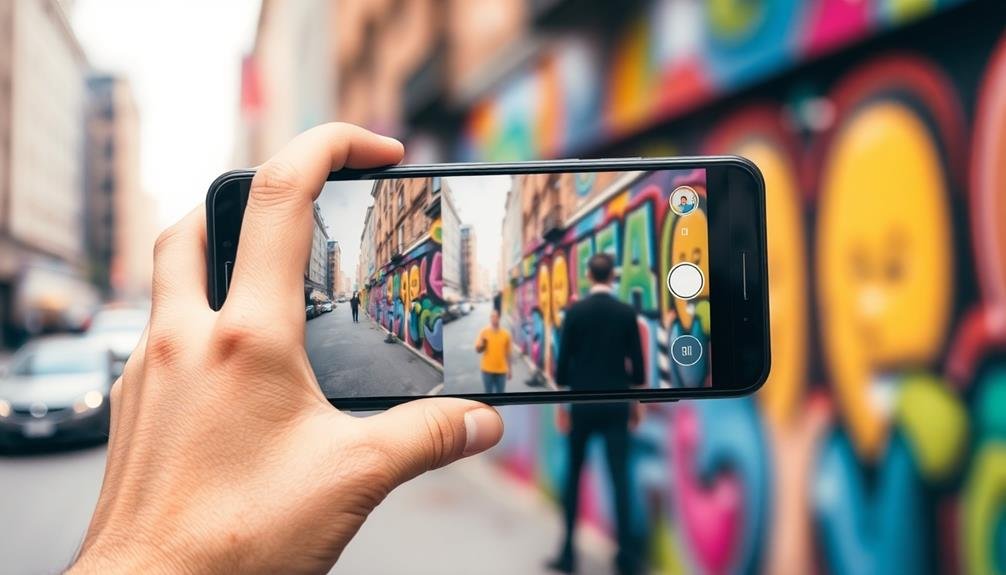
To develop a consistent style in your mobile photography, start by selecting a color palette that resonates with your personal aesthetic.
You'll want to experiment with different editing techniques until you find a signature approach that enhances your chosen palette.
Color Palette Choices
When developing a consistent style for your mobile photography, choosing a cohesive color palette is essential. Your color choices can greatly impact the mood and message of your images, helping to tell your unique story.
Consider the emotions and themes you want to convey through your photos, and select a palette that aligns with these goals. Experiment with different color combinations to find what resonates with your style. You might opt for warm, earthy tones for a cozy feel, or cool blues and greens for a more serene atmosphere.
Don't be afraid to use bold, contrasting colors to create visual interest and draw attention to specific elements in your images.
When selecting your color palette, keep these factors in mind:
- Consistency across your photos
- Emotional impact of different hues
- Complementary and contrasting colors
- Seasonal influences on color choices
- Brand identity (if applicable)
Signature Editing Techniques
Consistency is key when developing your signature editing techniques for mobile photography. Your editing style becomes an extension of your visual voice, making your images instantly recognizable.
To create a cohesive look, choose a set of filters or presets that align with your aesthetic and stick to them across your photos.
Experiment with adjusting exposure, contrast, and saturation levels to find your preferred balance. You might favor bright, airy images or lean towards moody, high-contrast shots.
Pay attention to how you handle highlights and shadows, as these can dramatically impact the overall mood of your photos.
Consider developing a unique approach to specific elements, like skin tones or sky colors. You could also focus on particular editing techniques, such as adding grain for a film-like quality or using selective color adjustments.
Editing for Narrative Impact
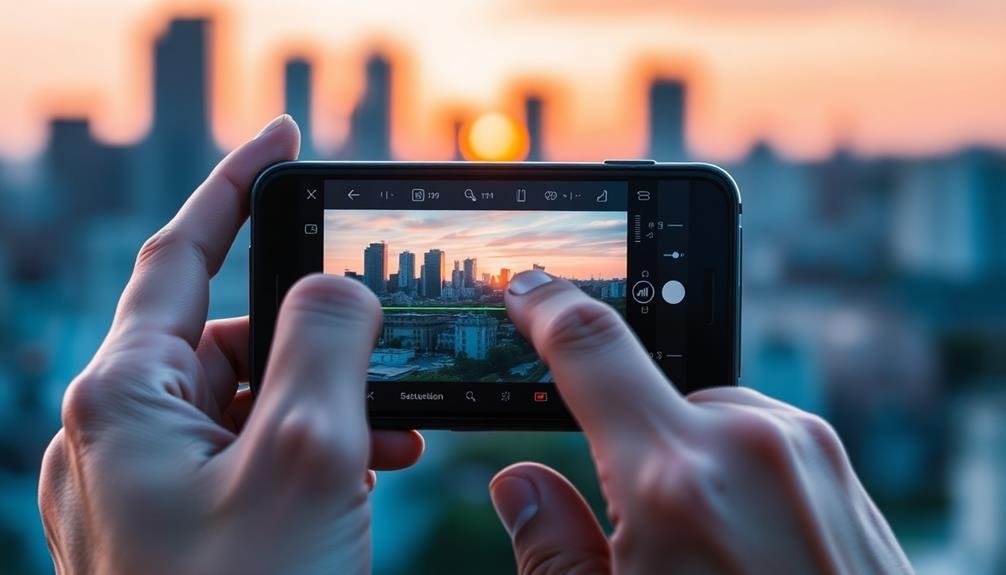
Editing your mobile photos can dramatically enhance their narrative impact. By carefully selecting and adjusting your images, you're crafting a visual story that resonates with your audience.
Focus on creating a cohesive visual flow that guides viewers through your narrative. Use consistent color tones and editing styles to tie your photos together, reinforcing the story's mood and atmosphere.
Consider the emotional impact of each image and how it contributes to your overall narrative. Crop photos to emphasize key elements and remove distractions. Adjust brightness, contrast, and saturation to highlight important details and set the right tone for each scene in your story.
To maximize narrative impact, consider these editing techniques:
- Use vignettes to draw attention to the central subject
- Apply selective focus to guide the viewer's eye
- Experiment with black and white for dramatic effect
- Enhance colors to evoke specific emotions
- Adjust exposure to create mood and atmosphere
Sequencing Photos for Storytelling

Crafting a compelling narrative through mobile photography hinges on skillful photo sequencing. You'll want to arrange your images in a way that guides viewers through your story, creating a logical and emotional flow.
Start by selecting a strong opening image that captures attention and sets the tone. This could be a wide shot establishing the scene or a close-up that intrigues viewers.
As you progress, alternate between different types of shots to maintain visual interest. Mix wide, medium, and close-up shots to provide context and detail.
Consider the emotional arc of your story, using images that build tension, reveal key moments, or provide resolution. Pay attention to visual connections between photos, looking for elements that connect one image to the next, such as similar colors, shapes, or themes.
End your sequence with a powerful closing image that leaves a lasting impression or ties everything together.
Leveraging Smartphone Camera Features

Modern smartphones come equipped with an array of powerful camera features that can greatly enhance your storytelling capabilities. By leveraging these tools, you'll be able to capture more compelling and expressive images that convey your personal narrative.
Start by familiarizing yourself with your phone's camera modes. Portrait mode creates a shallow depth of field, ideal for highlighting subjects against blurred backgrounds. Night mode allows you to capture low-light scenes with remarkable clarity, perfect for evening stories. Wide-angle lenses let you include more of your surroundings, providing context to your tale.
Don't overlook your smartphone's editing features. They're essential for fine-tuning your photos and ensuring they align with your story's mood.
Here are key editing tools to master:
- Exposure adjustment
- Color temperature correction
- Cropping for composition
- Filters for consistent aesthetics
- Contrast and saturation tweaks
Candid vs. Posed Shots
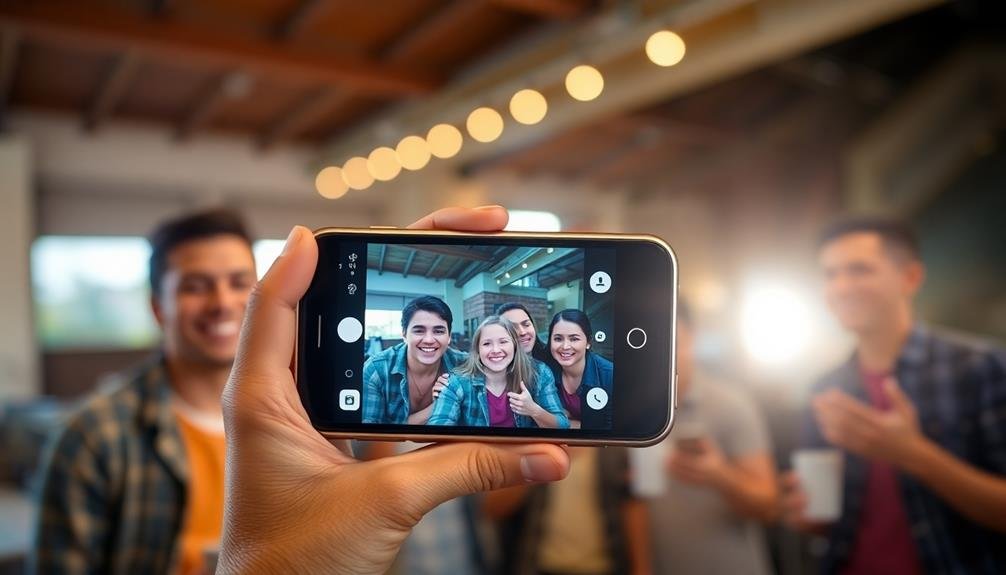
When it comes to mobile photography for personal storytelling, you'll often find yourself choosing between candid and posed shots.
Candid photos capture spontaneous moments, revealing genuine emotions and authentic interactions. They're unplanned and often catch subjects off-guard, resulting in natural expressions and body language. These shots can provide a raw, unfiltered glimpse into your daily life and relationships.
Posed shots, on the other hand, offer more control over composition and subject presentation. You can carefully arrange people, objects, and backgrounds to create a specific mood or convey a particular message.
While posed photos may lack the spontaneity of candid shots, they allow you to craft a deliberate narrative and highlight specific aspects of your story.
Both styles have their place in personal storytelling. Candid shots excel at capturing fleeting moments and real-life dynamics, while posed photos can emphasize important milestones or create visually striking images.
To tell a well-rounded story, consider mixing both types. Use candid shots to showcase everyday life and genuine interactions, and incorporate posed photos for significant events or when you want to convey a specific message or aesthetic.
Incorporating Environmental Elements

As you capture moments for your personal story, incorporating environmental elements can add depth and context to your mobile photos. Look beyond your main subject and consider including surrounding details that enhance the narrative. These elements can provide a sense of place, time, and atmosphere, making your images more immersive and evocative.
When framing your shot, pay attention to the background and foreground. Include architectural features, natural landscapes, or distinctive objects that give viewers a better understanding of the setting. Weather conditions, like rain, snow, or sunlight, can also contribute to the mood and story of your image.
Consider these environmental elements to enrich your mobile photos:
- Iconic landmarks or local attractions
- Seasonal changes in nature
- Cultural symbols or regional artifacts
- Unique textures or patterns in the surroundings
- Lighting conditions that create atmosphere
Sharing and Social Media Strategies

Once you've captured compelling mobile photos that tell your personal story, it's time to share them with the world. Choose platforms that align with your storytelling goals and target audience. Instagram's visual focus makes it ideal for photo-centric narratives, while Facebook allows for longer captions and broader reach.
Curate your content carefully, selecting images that best represent your story's essence. Create a cohesive feed by maintaining a consistent aesthetic or theme. Use hashtags strategically to increase discoverability, but don't overdo it. Craft engaging captions that provide context and invite interaction.
Timing matters. Post when your audience is most active to maximize engagement. Experiment with different posting schedules to find what works best. Utilize features like Instagram Stories or Facebook Live to share behind-the-scenes moments or real-time updates.
Engage with your followers by responding to comments and participating in relevant conversations. Cross-promote your content across different platforms to reach a wider audience. Consider collaborating with other creators or brands that align with your story to expand your reach.
Frequently Asked Questions
How Does Metadata in Mobile Photos Contribute to Personal Storytelling?
Metadata in your mobile photos enriches your personal storytelling by capturing details you might forget. It records when and where you took the shot, preserving the context of your memories and adding depth to your digital narrative.
Can Mobile Photography Replace Traditional Journaling for Documenting Personal Experiences?
You can use mobile photography to complement traditional journaling, but it can't fully replace it. While photos capture visual moments, they may miss deeper thoughts and feelings that written entries can express more thoroughly.
What Role Do Photo-Editing Apps Play in Shaping Mobile Photography Narratives?
You'll find photo-editing apps essential in shaping your mobile photography narratives. They let you enhance, filter, and manipulate images, adding depth and emotion to your visual stories. You're able to craft a personalized aesthetic that reflects your unique perspective.
How Does Geotagging Affect the Storytelling Aspect of Mobile Photography?
Geotagging enriches your mobile photos' storytelling by adding location context. You're not just capturing an image; you're pinpointing where it happened. This feature helps you create a visual map of your experiences and adventures.
Are There Privacy Concerns When Using Mobile Photos for Personal Storytelling?
Yes, there are privacy concerns when using mobile photos for personal storytelling. You're sharing personal moments, locations, and potentially sensitive information. Be cautious about what you post, who can see it, and adjust your privacy settings accordingly.
In Summary
You've learned how to turn your mobile photos into powerful storytellers. By capturing authentic moments, harnessing emotion, and mastering composition, you're creating images that resonate. Don't forget to play with light, color, and your phone's features. Whether you're snapping candids or posed shots, incorporate your environment to add context. As you share your visual tales on social media, remember: your unique perspective is what makes your photos truly personal.





Leave a Reply